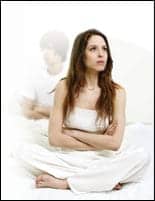Needing to avoid benzodiazepines, a clinical and research team turns to the selective serotonin reuptake inhibitor paroxetine and finds it resolves a patient’s symptoms.
By Lisa Spear
In the middle of the night, deep asleep with his eyes closed, a man would often initiate sex with his wife. While his wife wasn’t pleased to wake up in the dead of night, she never confronted her husband about his behavior. Then, one day, the man went camping with a group of his male friends. Once again, he started to act out sexually in his sleep, only this time his friends were less forgiving.
“To his embarrassment, he discovered what was happening,” says the treating physician, Richard Castriotta, MD, FCCP, FAASM, a sleep specialist in California.
Prior to the camping trip, this patient had no idea of his nighttime sexual acts because his wife never bothered to mention it.
“This is one of those disorders that is hard to diagnose because it is associated with amnesia, so the people who have the problem are unaware of it until someone else tells them,” says Castriotta, a professor of clinical medicine at the University of Southern California Keck School of Medicine in Los Angeles.
Sexsomnia is a little known sleep disorder that causes a person to perform sex acts during non-rapid eye movement sleep. These behaviors may include masturbation, intercourse, and fondling. Sexsomnia is a condition that often isn’t diagnosed until there are profound legal consequences, and clinicians may not know how to handle these patients since there is a paucity of research into treatment options.
A new case study, published in the Journal of Clinical Sleep Medicine, suggests that an antidepressant, paroxetine, can stop sexsomnia symptoms. The case review examines another male patient who, after the administration of the medication, experienced the complete resolution of his sexsomnia symptoms.1
In the published case report, the patient sought help from Castriotta because the condition was causing marital problems. Alcohol made the symptoms worse.
The main finding of the case report was that the use of paroxetine, better known by the brand name of Paxil, eliminated the patient’s symptoms. A selective serotonin reuptake inhibitor (SSRI), paroxetine has a depressive effect on libido, which is why Castriotta decided to prescribe it.
“We chose this drug paroxetine because it theoretically should be of help, and it was,” says Castriotta. “Serotonin availability seems to have an anti-libido effect.”
To date, there are fewer than 200 clinical cases of sexsomnia reported in medical literature, most of which are of men with the disorder. Most patients are treated with clonazepam, which belongs to the benzodiazepines drug class. Since alcohol made this patient’s symptoms worse, clonazepam (with its action on GABA receptors, potentially having similar effects as alcohol) was not indicated.
Sexsomnia is considered a parasomnia, which is a group of sleep disorders that are characterized by abnormal motor, verbal, or behavioral events that happen during sleep or on arousal from sleep. Parasomnia events can include night terrors and even sleep eating disorders. These sleep disorders are less understood than most, says Castriotta, and as a result there’s less medical attention directed toward them.
A literature review in the Journal of Clinical Medicine found that sexsomnia is not reported in the medical literature as often as other parasomnias. The authors suggest that the coexistence of sexsomnia and other sleep disorders should be more thoroughly examined, which could help in management.2
By publishing this latest case report, Castriotta and his colleagues hoped to draw attention and bring awareness to sexsomnia.
“It is not well known among the general population of general care physicians that this exists and unless you are already aware of the disorder, you are never going to diagnose it.”
Lisa Spear is the associate editor of Sleep Review.
References
1. Castriotta R, Gribach V, Kumar V. Resolution of sexsomnia with paroxetine. J Clin Sleep Med. 2020 Jul 15;16(7):1213-4. doi.org/10.5664/jcsm.8478
2. Martynowicz H, Smardz J, Wieczorek T, et al. The co-occurrence of sexsomnia, sleep bruxism and other sleep disorders. J Clin Med. 2018 Aug 23;7(9):233. doi:10.3390/jcm7090233



